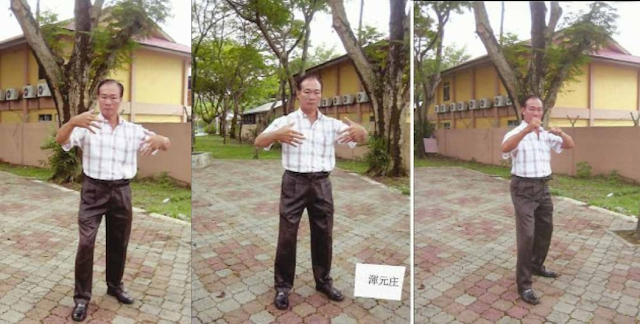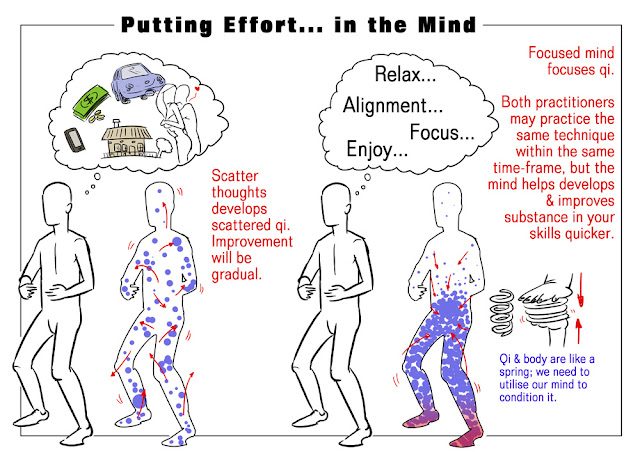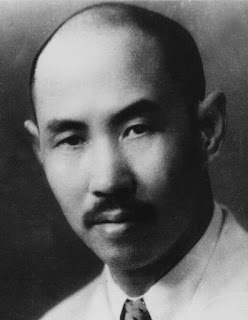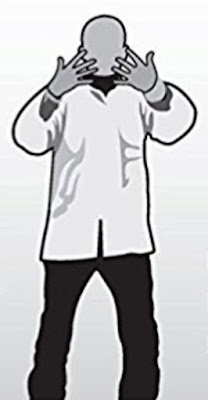意拳正軌
THE CORRECT
PATH OF YIQUAN
王薌齋
by Wang Xiangzhai [1929]
[translation
by Paul
Brennan, Aug, 2016]
PREFACE
技擊一道,甚矣哉之難言也。詩言拳勇,禮言角力,皆技術之起源。降至漢代,華陀氏作五禽之戲,亦技擊本質,良以當時習者甚少,以致湮沒無聞。迨至梁天監中,達摩東來,以講經授徒之餘,兼及鍛練筋骨之術,採禽獸性靈之特長,參以洗髓易筋之法,而創意拳,又曰心意拳。徒衆精是技者甚多,少林之名,亦因之而噪起。岳武穆王復集各家精華,編為五技連拳散手撩手諸法,稱為形意拳。逮及後卋,國家宴安,重文輕武之風日盛,又精拳技者,復多以好勇鬥狠賈禍,於是士大夫相率走避,致捋此含有深奧學理之拳術,不能見重於歷世。相沿既久,無可更易,即後卋之有道懷瑾握瑜者,率多埋沒於鄉邨閭里間,不敢以技術著稱,此固使後學之深資悼惜者也。清代晉之太原郡,戴氏昆仲,精於是技,而獨詳傳於直隸深縣李洛能,先生授徒甚衆,獲復李老先師之絕技者,厥同縣之郭雲深先生。郭先生之教人習形意也,首以站樁為入學初步。從學者多矣,能克承其教者,迨不多遘,郭先生亦有非其人不能學,非其人不能傳之歎。吾與郭先生同里,有戚誼為長幼行,愛吾聰敏而教之,且於易簀之時,猶以絕藝示之,諄諄以重視相囑。晚近卋風不古,學者多好奇異,殊不知真法大道,只在日用平常之間,世人每以其近而忽之道不遠人,人之為道而遠說益徵。薌不願以此而求聞達,無如晚近世俗,趨於卑下,不求實際,徒騖虛名,於是牟利之徒,不自學問,抄襲腐敗之陳文,強作謀生之利器,滿紙荒唐,故入玄虛,忽而海市蜃樓,跡近想像;忽而高山遠水,各不相干。使學者手不釋卷,如入五里霧中,難識半點真偽。一般無知之士,猶以聖人之道,不可鑽仰。嗚呼,利人當途,大道何昌。午夜深思,曷勝浩歎。薌雖賦性不敏,而於技擊一道,竊焉心喜,既獲得親炙真法大道之指導,每日承其教誨之語言,多具有紀載之價值者,連綴成冊,本利己利人之訓,不敢自私,以期同嗜均沾斯益,非徒以此問卋也,是序。
中華民國拾八年菊月 深縣王宇僧
The way of martial arts is really very hard to describe. The Book of Poetry
says [poem 198]: “They are without fists, without courage.” The Book of Rites
[chapter 6] mentions the training of wrestling [alongside archery and
charioteering]. Such references are the source of our martial arts. During the
Han Dynasty, Hua Tuo made his Five Animal Frolics, which also had a martial
quality, but because there were too few practitioners at the time, that aspect
disappeared.
Then in the Tianjian era of Emperor Wu of the Liang Dynasty [502—519], Damo
traveled east. In addition to teaching the Buddhist sutras, he also taught
skills of training the body. Drawing from the special attributes of animals, he
produced the methods of Marrow Washing and Sinew Changing, and created Yiquan
[“Intention Boxing”], also called Xinyiquan [“Mental Intention Boxing”]. There
were many skilled experts of it. It was called “Shaolin” because that is where
the practice began. Yue Fei then collected the essences of various systems and
compiled them into the methods of “five techniques continuous boxing”,
“miscellaneous hands”, and “throwing hands”, his art becoming known as
Xingyiquan [“Form & Intention Boxing”].
When the nation was later at peace, the attitude steadily grew that literary
pursuits were important and martial pursuits were irrelevant. Moreover, martial
arts experts were often too in love with fighting and caused trouble, resulting
in the literati shunning martial arts more and more. Even though some of these
boxing arts had profound theories, scholars were unable to see their historical
importance. Systems were passed down for a long time without any modifications
being made, and when later generations came up with methods that also had
excellent qualities, they were usually hidden away in their native villages and
they did not dare to spread their arts. This indeed fills us modern students
with deep grief.
During the Qing Dynasty, in Taiyuan, Shanxi, the Dai brothers excelled in
martial arts, but they taught their whole art only to Li Luoneng of Shen
County, Hebei. Li taught many students, the finest being Guo Yunshen, also of
Shen County. Guo’s teacher taught him Xingyi, emphasizing stance work as the
first stage of fundamental training. Students have too often been allowed to
skip that part of the teaching, and now it is hardly seen anymore. Guo was
already worried, not that people would not be able to learn it, but that people
would not be able to teach it. Guo and I were from the same town, and our bond
was that between an old man and a young man. He taught me in the first place
because he considered me to be intelligent, and then when he was on his
deathbed, still showing the height of skill, he tirelessly encouraged me to
maintain serious training.
In recent years, people no longer behave as they did in the previous era.
Students usually prefer weird new things, and they have no comprehension for
true arts and great ways. Every day, people keep forgetting this wisdom [from
the Zhong Yong]: “The Way is not far from people. It is their expectation of
the Way that distances them from it.” They are no longer willing to use such
wisdom to seek what is truly great, and it has unfortunately become customary
in recent years to incline toward what is inferior. Instead of striving for
real life, they pursue empty fads. They pursue personal gain rather than
self-knowledge. In imitation of corrupt literature, they seek power in order to
get ahead, pages full of nonsense tricking them with illusions.
They ignore that what they seek is a mirage and chase their fantasies. They
ignore the sheer scale of the real world and treat it as irrelevant. To push
students to be studious is therefore like sending them into miles of fog. They
can barely tell at all what is real and what is fake. Ordinary ignorant people
seem to use the Way of the sages, but they cannot be bothered to go into it [to
“drill into it or look up at it”, paraphrasing Lun Yu, 9.11: “The more I look
up at his teaching, the higher it goes. The more I drill into his teaching, the
harder it gets.”] Alas. Good men set out on the path, but where does the great
Way flourish? They contemplate it in the middle of the night, but how do they
keep themselves from sighing in despair?
I am not endowed with great intelligence, but I do have a heartfelt delight for
martial arts. I was given personal guidance in the genuine art, and every day I
carry on my teacher’s words. I have made a record of his precious ideas and
compiled them into a book. Setting the example of benefiting both self and
others, I not dare to keep it to myself. Hoping to share the benefits with
fellow enthusiasts, the least I can do is publish this document.
– written by Wang Yuseng [Xiangzhai] of Shen County,
during the “chrysanthemum month” [Oct], 1929–



















